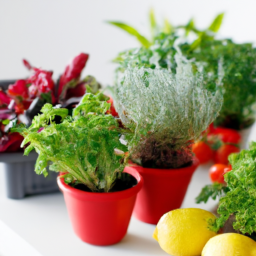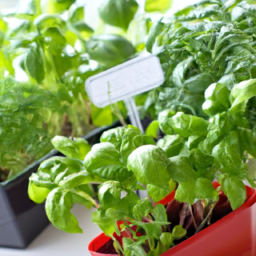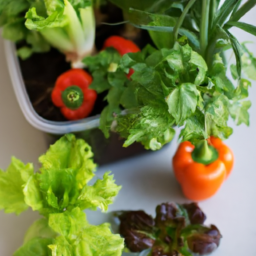
Are you looking to start your own indoor vegetable garden but not sure where to begin? Well, you’re in luck! In this blog post, we will discuss the best vegetables to grow indoors. Whether you have limited outdoor space, live in a cold climate, or simply want to enjoy fresh produce year-round, growing vegetables indoors can be a rewarding and convenient way to satisfy your green thumb. So, let’s dive in and explore some of the top veggies that thrive in indoor environments.
Benefits of Growing Vegetables Indoors
Improved Air Quality
When you grow vegetables indoors, you are not only providing yourself with fresh, homegrown produce, but you are also improving the air quality in your home. Plants naturally absorb carbon dioxide and release oxygen through the process of photosynthesis. This can help to reduce indoor air pollution and create a healthier living environment for you and your family.
In addition to producing oxygen, indoor plants can also help to remove harmful toxins from the air. Many common household items, such as cleaning products and furniture, can release volatile organic compounds (VOCs) into the air, which can have negative effects on your health. By growing vegetables indoors, you can help to filter out these toxins and create a cleaner, fresher indoor environment.
Year-Round Harvest
One of the biggest benefits of growing vegetables indoors is the ability to have a year-round harvest. Unlike outdoor gardens, which are subject to the changing seasons and weather conditions, indoor gardens can thrive in a controlled environment. This means that you can enjoy fresh, homegrown vegetables no matter the time of year.
By growing vegetables indoors, you can also extend the growing season for certain crops that may not do well in your climate. For example, if you live in a cold climate, you can grow warm-weather vegetables like tomatoes and peppers indoors during the winter months. This can help you to diversify your harvest and enjoy a wider variety of produce throughout the year.
Space-Saving Solution
Another benefit of growing vegetables indoors is that it is a space-saving solution for those with limited outdoor space. Whether you live in a small apartment or a house with a tiny yard, indoor gardening can help you make the most of the space you have available. You can grow vegetables in containers on windowsills, countertops, or shelves, making it easy to incorporate gardening into your home decor.
In addition to being space-saving, indoor gardening can also be a more convenient option for those with physical limitations. By growing vegetables indoors, you can avoid the need to bend, stoop, or kneel, making it easier for people with mobility issues to enjoy the benefits of gardening. This can help to make gardening more accessible to a wider range of individuals and ensure that everyone has the opportunity to experience the joys of growing their own food.

Best Vegetables to Grow Indoors
Top Vegetables for Indoor Gardening
Indoor gardening is a great way to enjoy fresh vegetables year-round, even if you don’t have a backyard or outdoor space. With the right setup and care, you can grow a variety of vegetables right in your own home. Here are some of the best vegetables to grow indoors:
Tomatoes
Tomatoes are one of the most popular vegetables to grow indoors because they are relatively easy to care for and produce a bountiful harvest. To grow tomatoes indoors, you will need a sunny spot near a window or artificial grow lights. Make sure to choose a compact variety that is suitable for indoor growing, such as cherry tomatoes.
When growing tomatoes indoors, it is important to provide support for the plants as they grow. You can use a trellis or stakes to help the plants stay upright. Water the plants regularly and fertilize them with a balanced fertilizer to promote healthy growth and fruit production.
Harvest your tomatoes when they are ripe and enjoy them fresh or use them in your favorite recipes. With proper care, you can enjoy homegrown tomatoes all year long.
Peppers
Peppers are another great vegetable to grow indoors because they are compact plants that can thrive in containers. Choose a variety of peppers that suits your taste preferences, such as bell peppers or spicy chili peppers. Peppers require plenty of sunlight, so make sure to place them in a sunny location or use grow lights.
When growing peppers indoors, it is important to provide consistent moisture and fertilization. Peppers are heavy feeders, so make sure to fertilize them regularly with a balanced fertilizer. Water the plants when the top inch of soil is dry to the touch.
Harvest your peppers when they reach the desired size and color. Peppers can be used fresh in salads, stir-fries, or roasted dishes. With proper care, you can enjoy homegrown peppers throughout the year.
Herbs
Herbs are some of the easiest vegetables to grow indoors because they require minimal space and care. Choose a variety of herbs that you use frequently in your cooking, such as basil, parsley, mint, or cilantro. Herbs can be grown in small pots on a sunny windowsill or under grow lights.
When growing herbs indoors, it is important to provide well-draining soil and water the plants when the top inch of soil is dry. Avoid overwatering, as this can lead to root rot. Harvest the herbs as needed by snipping off the leaves with scissors.
Herbs can be used fresh in a variety of dishes, including salads, soups, and pasta. They can also be dried or frozen for later use. With proper care, you can enjoy fresh herbs year-round right from your own kitchen.

Tips for Successfully Growing Vegetables Indoors
Choosing the Right Vegetables
When it comes to growing vegetables indoors, it’s important to choose the right ones that will thrive in an indoor environment. Some vegetables are better suited for indoor growing than others. Here are a few vegetables that are known to do well indoors:
1. Herbs – Herbs like basil, parsley, and chives are great options for indoor growing. They don’t require a lot of space and can be grown in small containers on a sunny windowsill.
2. Leafy Greens – Vegetables like lettuce, spinach, and kale are also good choices for indoor growing. They can be grown in shallow containers and don’t require a lot of light to thrive.
3. Tomatoes – While tomatoes do require more light than some other vegetables, they can still be grown indoors successfully. Choose a compact variety and provide plenty of light for best results.
4. Peppers – Peppers are another vegetable that can be grown indoors, as long as they receive enough light. Choose a smaller variety like bell peppers or chili peppers for best results.
Providing the Right Growing Conditions
In order for your indoor vegetable garden to thrive, it’s important to provide the right growing conditions. Here are a few tips to help you create the perfect environment for your plants:
1. Light – Most vegetables require at least 6-8 hours of sunlight per day to grow successfully. If you don’t have access to natural sunlight, you can use grow lights to provide the necessary light for your plants.
2. Temperature – Most vegetables prefer temperatures between 65-75 degrees Fahrenheit. Make sure to keep your indoor garden in a warm, draft-free location to ensure optimal growth.
3. Watering – Overwatering is a common mistake when it comes to indoor gardening. Make sure to water your plants only when the soil feels dry to the touch, and be sure to provide good drainage to prevent root rot.
4. Soil – Use a high-quality potting mix that is specifically formulated for vegetables. Make sure the soil is well-draining and rich in nutrients to support healthy plant growth.
Caring for Your Indoor Vegetable Garden
Once you’ve chosen the right vegetables and provided the right growing conditions, it’s important to care for your indoor garden properly to ensure success. Here are a few tips to help you care for your plants:
1. Pruning – Regularly prune your plants to promote healthy growth and prevent overcrowding. Remove any dead or yellowing leaves, as well as any stems that are growing too close together.
2. Fertilizing – Use a balanced fertilizer to provide your plants with the nutrients they need to thrive. Be sure to follow the instructions on the fertilizer package and avoid over-fertilizing, as this can harm your plants.
3. Pest Control – Keep an eye out for pests like aphids, spider mites, and whiteflies, which can damage your plants. Use natural pest control methods like neem oil or insecticidal soap to keep pests at bay.
By following these tips, you can successfully grow a variety of vegetables indoors and enjoy a bountiful harvest year-round. Happy gardening!
Here are the Essential Points
If you’re looking to start a small indoor garden, growing vegetables can be a great way to get started. Not only are vegetables easy to grow indoors, but they also provide a fresh and healthy addition to your meals. Some of the best vegetables to grow indoors include cherry tomatoes, peppers, and herbs like basil and parsley. These vegetables thrive in indoor environments and can be easily grown in containers or small pots.
One of the main benefits of growing vegetables indoors is that you can control the growing conditions, such as temperature, light, and water, to ensure optimal growth. Additionally, growing your own vegetables indoors can save you money and provide you with a sense of satisfaction knowing that you’re growing your own food. Whether you have a small apartment or limited outdoor space, growing vegetables indoors is a convenient and rewarding way to enjoy fresh produce year-round.
FAQ Roundup:
Q1: What are the best vegetables to grow indoors?
A1: Some of the best vegetables to grow indoors include cherry tomatoes, lettuce, peppers, herbs like basil and parsley, and green onions. These vegetables thrive in containers and require minimal space and sunlight.
Q2: How much sunlight do indoor vegetables need?
A2: Most indoor vegetables require at least 6-8 hours of sunlight per day. If you don’t have access to natural sunlight, you can use grow lights to provide the necessary light for your plants to thrive.
Q3: What type of containers should I use for indoor vegetable gardening?
A3: When growing vegetables indoors, it’s best to use containers that have drainage holes to prevent overwatering. You can use plastic or ceramic pots, hanging baskets, or even repurpose containers like old buckets or crates.
Q4: How often should I water my indoor vegetables?
A4: The frequency of watering your indoor vegetables will depend on the specific plant and the conditions in your home. Generally, you should water your plants when the top inch of soil feels dry to the touch. Be sure not to overwater, as this can lead to root rot.
Q5: Can I grow vegetables indoors year-round?
A5: Yes, you can grow vegetables indoors year-round as long as you provide them with the right conditions, such as proper lighting, temperature, and humidity. Some vegetables may have specific growing seasons, but with the right care, you can enjoy fresh produce all year long.
Dr. Olivia Green is a botanist with over two decades of experience in indoor plant cultivation. She holds a Ph.D. in Plant Biology and has dedicated her career to researching plant behavior in controlled environments. Dr. Green is passionate about helping plant enthusiasts master the art of indoor gardening through her extensive knowledge and practical insights.


